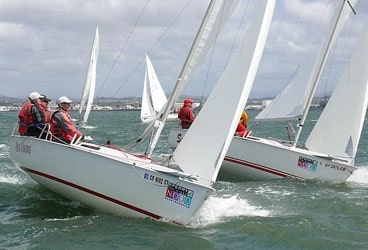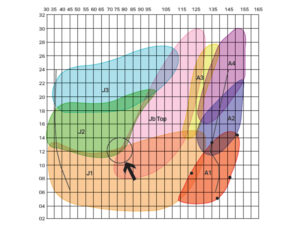
high wind sailing 368
After a weekend of heavy-air sailing, I felt prompted to record some of the lessons learned. The best we could do in this particular regatta was second overall, which may actually be better than a sharp stick in the eye because it does result in a more careful post-race analysis and the admission that it takes a while to remember some of the fine points. After a few hundred yards, I became fully aware that in heavy air (in dinghies and racing keelboats, at least) speed through the water is what counts most.
Nothing else works right if the boat is slow-slow because the sail trim is wrong, slow after a tack, slow after hitting a wave, slow because of too much heeling, slow because of poor steering. Slow is the enemy. And slow is common. In heavy air, most boats are going slower than they could, slower than they would in moderate air.
Speed is far more important than tactics. One is best advised to keep away from other boats and look for clear air on long tacks that permit the development of optimal speed. Keeping away from other boats begins at the start. Don’t worry about the ideal place on the line; start in clear air going in the direction you intend to go. And because the fleet tends to start en masse in the middle of the line, it is sometimes easy to find a big hole at the favored end.
In heavy air, upwind speed requires competent steering. In no other situation is the helmsman so important; he must not allow himself to be distracted by anything else. Speed is dependent on keeping the airfoils at a constant position in the air stream and the hydrofoils at a constant position in the water stream. Consequently, every nuance of variation in wind strength or wave size requires an immediate luff or bear away so as to keep the boat high on the wind, at a constant angle of heel, and at full speed.
I remember watching Jesper Bank leading the fleet up the final weather leg in a 20-knot offshore breeze. His mast was fixed in the air flow, steady as a rock, at about 10 degrees of heel as he moved steadily farther ahead of the fleet. In the early days when I was worrying about keeping my International 14 from heeling too much to leeward, Hartley Watlington told me, “Never let the boat heel to windward,” i.e., “keep the angle of heel constant.” It took me years to understand that “keep the horizon level” was Buddy Melges speak for “keep the angle that the jibstay makes with the horizon constant.” The underlying message is that the helmsman must keep the angle of heel constant, that he should be so glued to steering-up in every slight gust and down in every let-up, parrying every wave-that the boat never slows.
One must adjust every trim control to this end. If the boat slows, its leeway increases, it is more susceptible to heeling in the gusts, and it requires distracting adjustments to get it going again. Speed helps to keep the boat upright by bringing the apparent wind forward. It reduces the disparity between the apparent wind and the true wind and therefore modulates gust and lull variations. It makes the boat more responsive to rudder variations and therefore easier to steer and more easily controlled in gust/lull changes and waves.
Crew weight is a great asset. More crew weight also makes the boat steadier, less responsive to changes in wind velocity and waves and easier to keep at the optimal angle of heel. But what really matters is that at a given wind strength a heavy crew can keep their sails fuller, generating more aerodynamic force at the same angle of heel and therefore going faster, than can a light weight crew.
Because slowing occurs with every tack (even good tacks) and in heavy air bad ones are common, one should avoid tacking. Don’t hit the corners, but stay on one tack until you have a really good reason to switch. We learned not to tack on an opponent’s leebow (unless he is on the layline), because shortly after the start when we did so, one of the Canadians drove over us before we could get up to speed. Thereafter, whenever possible, we preserved speed by ducking, and made sure we could release the mainsheet before we did so. Avoid the port layline as it requires a tack at the mark when you least want to slow down.
During and immediately after a tack, the jib sheet should be eased and the main traveler dropped to leeward. After completing the tack, head low and build up speed as you gradually sheet the jib in, bring the main traveler toward the centerline and head higher. Don’t bring the main traveler all the way up until you are at full speed and at the appropriate angle of heel. Most of your competitors are losing with every tack, so one can make significant gains by merely reducing the amount of slowing that you incur with yours.
Pointing is not a goal. Aiming high is slow and slow means excessive leeway (not as much lift from the underwater foils) so that you lose “gauge.” The faster you go the higher you go-almost regardless of how high you are heading.
That crew weight pays means keeping the sails as full as possible at the optimal angle of heel is valuable, not as flat as possible, but as full as possible and as close to the centerline as possible while avoiding excessive heeling. In other words, do not flatten the sails too much. In most boats it is best to keep the mainsheet in hard and play the traveler as the latter is so much easier to control. Use as much backstay/jibstay as is necessary to flatten the main and as much tack downhaul as is necessary to flatten the jib in order to keep the boat on its feet and feel fast, but no more.
Over flattening the main in heavy air is one of the most common mistakes for at least three reasons: 1. Excessive backstay: “It’s blowing, so pull it in as much as you can.” (I can remember saying that). In boats with a flexible mast it’s easy to get too much rig bend. 2. Excessive lower shroud tension. We want to get a little lateral mast tip fall off so as to reduce the heeling moment in gusts. A little is OK, but not so much as there is no power left in the upper sail. 3. Excessive rake. If there is too much rake, the mainsheet will become two-blocked and you will be unable to get the main leech as tight as need be. The solution (in boats with adjustable jibstays) is to tighten the jibstay which tightens the main leech directly by reducing the rake. With any of these three mistakes, the mainsail will have insufficient forward thrust, the boat will be slow and its leeway will increase.
I tried to make the sails fuller with every letup by easing the backstay and the jib tack (and vice versa). After the boat was under control and moving, I kept trying to ease the backstay, to bring the traveler up and to ease the jib tack downhaul. I knew that if I could keep the boat upright, feathering along close to the wind at a fixed angle of heel with the main a little fuller (its leech a little tighter) and the boom a little more on the centerline, she’d be a little faster and that we would go even higher.
Sail flattening has to be done in the context of aiming the boat high and reducing the heeling force, which brings us back to steering and keeping the boat doing three things simultaneously: going fast, keeping the angle of heel and the direction headed (the apparent wind angle) as constant as possible and heading as high as possible. We did our best to show the heavyweights that we could beat ’em at their own game. We were unsuccessful, but we thought we attained an honorable second.
I remember watching (from a power boat) a Soling championship at Punta Gorda, Fla., with Buddy Melges. The wind suddenly increased from 10 to 20 knots. The gusts were controlling the boats rather than the helmsmen and many of them were being blown over and sliding to leeward. Buddy attempted to remind them that heading high, a condition which-though difficult to achieve-is surprisingly easy to maintain, was essential to heavy air performance. He shouted to the leader, Chief Abbott, as loudly as he could, “Stick it up into the wind!”









